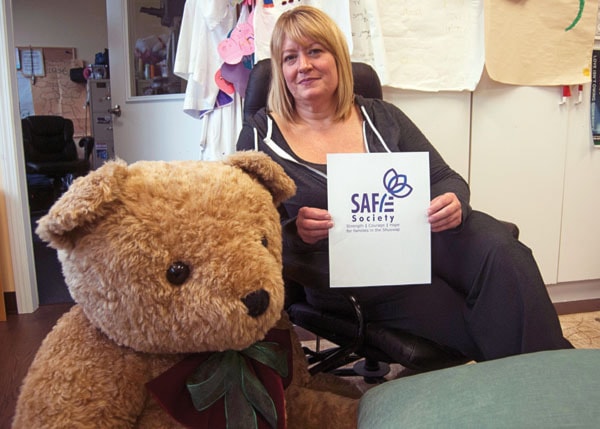Large inviting cushions, writings about hope, giant stuffed animals.
This is the office of the SAFE Society’s Children Who Witness Abuse (CWWA) program, where young people who have been exposed to domestic violence receive help.
The office is one of the places where program co-ordinator Colleen Making can provide support and education. She sees about 25 children per week there, with the waitlist for after-school appointments about six months long.
To reach more young people, she also works from the schools.
“We try to find creative solutions...”
The society received a grant from the BOAG Foundation earlier this year, which has aided her work in the school district.
“It is a sad statement – we value children and prevention, but we don’t fund it. However, grants like the Boag Foundation allow us to expand the existing services and reach out to isolated and vulnerable children,” Making says, explaining that the SAFE Society’s reach includes the North Shore, Sorrento, Silver Creek, Salmon Arm, Grindrod, Sicamous and Malakwa.
“We have a great office space for the kids in Salmon Arm who can access it, but lots of kids never get to come here,” she says, noting that it’s the support of the community and of grants that allow her to drive to outlying communities.
“The Boag Foundation – it’s a yearlong project and the goal is to reduce the risk of bullying and violence in young relationships. And it is that prevention piece.”
The SAFE Society kicked off the project with the Robb Nash event in May. Nash is a dynamic musician and speaker who has made it his mission to tell youth that no matter what their struggles are, they have a purpose and the ability to create change. He will be coming back to Salmon Arm in June next year.
“We want people to come to that, we want parents to come to that,” says Making. “A couple of school counsellors said we saved a couple of kids’ lives; they disclosed their suicidal thoughts.”
Making is in demand at schools from Sicamous to Silver Creek. Her focus depends on the age of the students and the particular concerns of the school, and can vary from better communication to healthy relationships.
She has also facilitated several groups, such as a summer camp for young boys to help them cope with anger.
During Making’s 19 years with the program, the need has not decreased, but issues have changed.
“I think definitely there are societal changes I’ve seen, versus what is acceptable and unacceptable. Cyberbullying seems easier, and ‘what’s the big deal – she deserved it’” is a more common reaction, Making says.
She points out that with the Internet, there’s no cooling-off period. “It’s awareness about prevention, it’s taking a second thought before you post something – because it is forever.”
She also notes that: “Children want to be heard. If they’re not being heard at home, they’re going to be heard somewhere else.”
It’s important for youth to stand up against bullying, she adds, a facet of the training she provides.
“I know there have been instances at school where a boy has shoved his girlfriend into a locker. We need other boys to say, ‘hey, that’s not cool.’”
The Boag Foundation grant also helped with an updating of the SAFE Society’s website as well as a new logo, redesigned with help from Salmon Arm Secondary students. It promotes strength, courage and hope for families in the Shuswap.
Overall, prevention is key, Making says.
Statistics from 1999 showed that 79 per cent of the inmates at the Kamloops Regional Correctional Centre came from violent homes, she notes.
She says the CWWA program couldn’t exist without the community’s support, and she would like to see the government understand better the value in prevention.
“I have passion for the program that I do, and I know the prevention does make a difference. You plant seeds and children think, ‘Oh, I don’t have to be this way... and that creates a bigger chain of events of change, a bigger change.”
